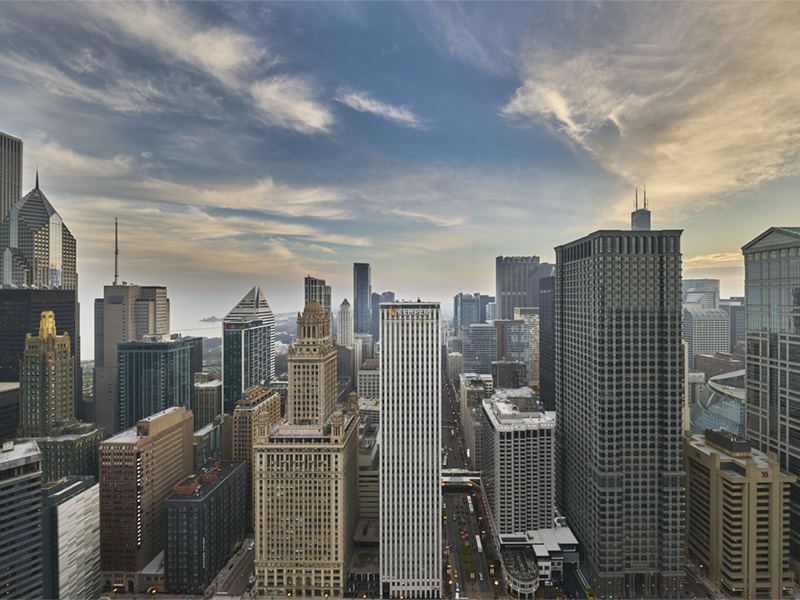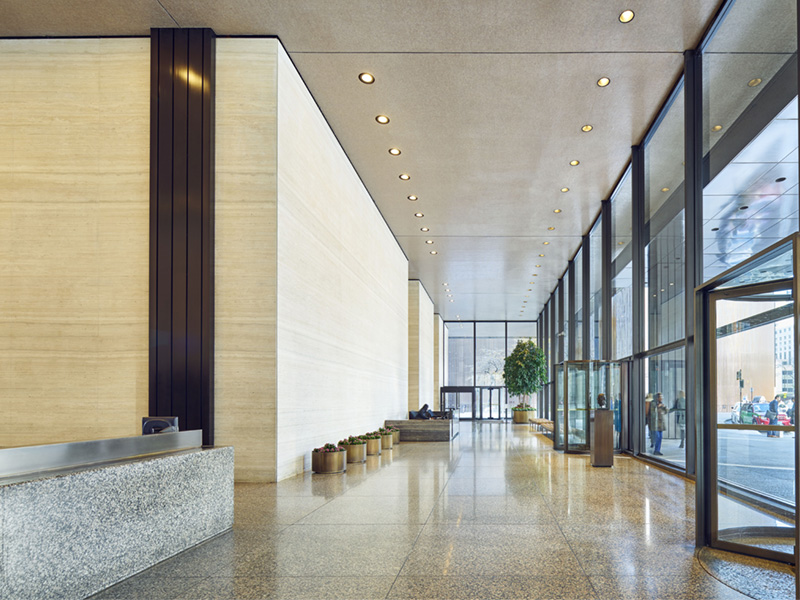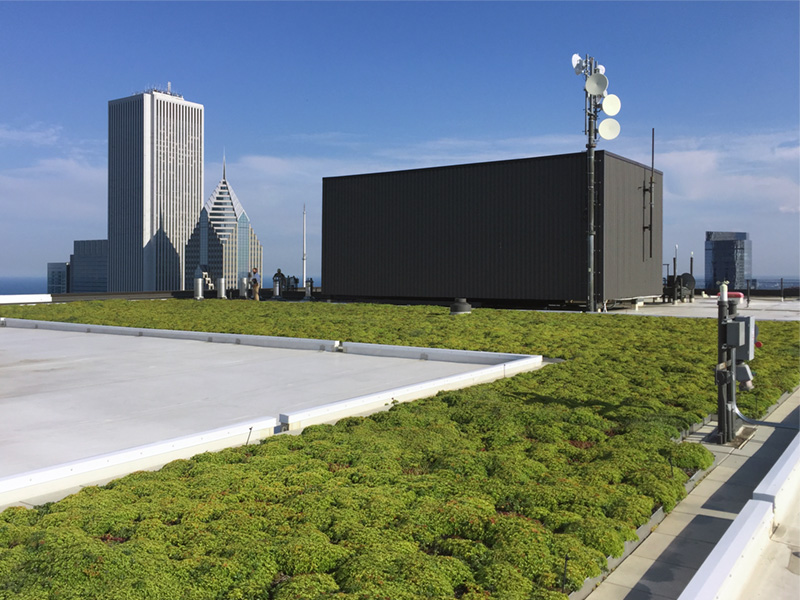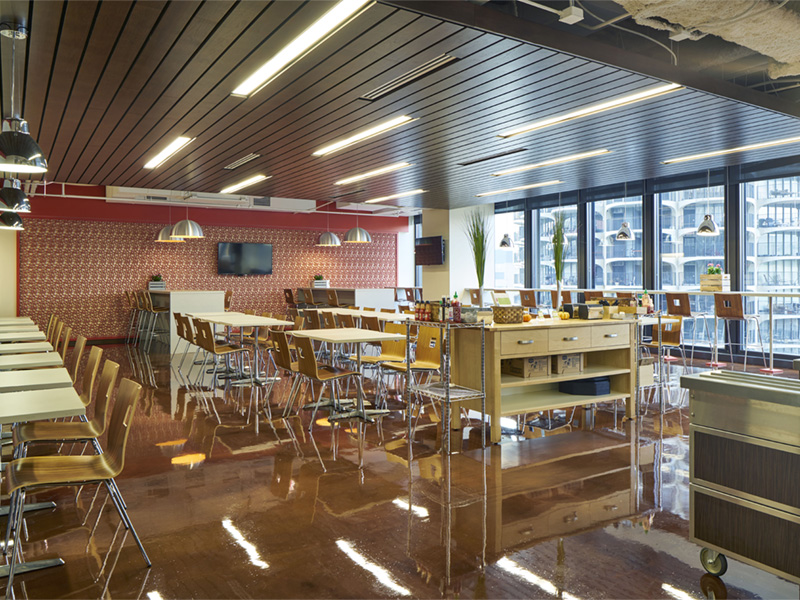Beacon Capital Retrofits AMA Plaza
Beacon Capital Partners purchased the building Sept. 29, 2016, and continued the eco-friendly effort of the building's former owners. In fact, the company plans to invest an extra $20 million into the property over the next five years.
by IvyLee Rosario

The AMA Plaza tower, built in 1992 and designed by Ludwig Mies van der Rohe, houses more than 1 million square feet of office space and a five-star hotel
With such accomplishments as an ENERGY STAR Partner of the Year award, a 2016 TOBY Award from BOMA and LEED Gold Certification, the landmarked AMA Plaza, located at 330 N. Wabash Ave. in Chicago, is buzzing with its sustainability efforts. The 50-story building underwent extensive renovations totaling $75 million from 2007 to 2012, with then-owner 330 N. Wabash Avenue LLC and property manager Riverview Realty Partners, gutting and rebuilding each floor. Beacon Capital Partners purchased the building Sept. 29, 2016, and continued the eco-friendly effort. In fact, it plans to invest an extra $20 million over the next five years.
“We’ve been committed to sustainability for decades,” said Al Scaramelli, managing director at Beacon. “We want to transform properties to create a distinctive workplace for our tenants and investors. We focus on sustainability because at the end of the day, it’s the right thing to do.”
Energy Strikes
 There was much to be upgraded with this property, including its lighting, HVAC systems, technology, mechanics, water and energy use. Susan Hammer, AMA Plaza’s longtime property manager, first with Riverview and now with JLL, explained that updating an existing building to be sustainable is not a simple task. “There was a comprehensive and balanced approach to these upgrades. We couldn’t just start with one thing. We had to integrate different processes and systems into our overall plan for the building.” The building was energy efficient when it opened in 1972, but green features have come a long way in the last 45 years, so the property required a large overhaul.
There was much to be upgraded with this property, including its lighting, HVAC systems, technology, mechanics, water and energy use. Susan Hammer, AMA Plaza’s longtime property manager, first with Riverview and now with JLL, explained that updating an existing building to be sustainable is not a simple task. “There was a comprehensive and balanced approach to these upgrades. We couldn’t just start with one thing. We had to integrate different processes and systems into our overall plan for the building.” The building was energy efficient when it opened in 1972, but green features have come a long way in the last 45 years, so the property required a large overhaul.
The building was all electric, so JLL and 330 N. Wabash Avenue LLC decided to add gas boilers instead of electric steam heat, which would save on energy costs. The modular system gives the building fuel source flexibility and greater capability to more efficiently respond to dynamic system loads. It also features new variable-speed pumps serving tenant fan-powered box reheat coils. The new boiler system yields an approximate 50 percent savings over the old electric steam heat boiler system.
During the first year in service, the savings for the two coldest months of the year was calculated at $139,946. Mechanical upgrades included the addition of variable-frequency drives, as well as control and technological advances, which saved three million kilowatt-hours per year over the building’s original performance. The lighting retrofit, which included the addition of LEDs and a daylight harvesting feature in the lobby that automatically dims the lights according to the amount of sunlight entering the building, produced a savings of two million kilowatt-hours per year, or 70 percent less energy. Water conservation programs brought a 20 percent savings during redevelopment of the landscaping by using low-water plants, including native perennial and sedum plants, meters on all hoses and the green-roof water supply to monitor usage and to detect leaks. There was also a restroom retrofit that incorporated low-flow fixtures, such as toilets that use 1.60 gallons of water per minute (gpm), urinals at 1 gpm and faucet aerators at 0.5 gpm.

The roof at AMA Plaza is home to Beacon Capital’s vegetable garden and bee program, which harvests honey twice a year and is available for tenant tours.
During reconstruction, new HVAC systems were added on each floor, which cut energy use by 35 percent. Beacon plans to upgrade the HVAC on six more floors as well as adding in newer software technologies to monitor energy usage. “We will be looking at how we use energy throughout the day. Are we turning on the heating/cooling too early or late? Now we have a software that looks at that every five minutes to see what is not being run correctly,” explained Scaramelli. “This is software that analyzes equipment in buildings—the valves, switches—and tells if it’s not working right.”
Half of the roof houses a green vegetable garden, which is not only environmentally good for carbon dioxide emission reduction but also slows the amount of rainfall runoff that goes to the sewer system. The white solar reflective roof also helps to keep the building cool in the summer.
Honey of a Deal
The newest sustainability measure is Beacon’s bee program. In collaboration with Boston-based Best Bees Co.—which delivers, installs and manages beehives—Beacon has installed beehives on the roofs of 19 of its properties to address the drop in population of this important contributor to the ecosystem. The partnership is intended to promote research efforts. Two hives on top of AMA Plaza are harvested twice a year, producing about 400 jars per property, per year, that are delivered to the tenants. “We like to get the tenants involved in this process,” said Scaramelli. “So we give them free honey, offer them tours with the beekeepers and even hold contests to name the queen bees.”

Tenants have access to an amenity kitchen in which they can enjoy a meal, conduct meetings and sample the vegetables picked from the rooftop garden.
In addition to the honey samples and rooftop tours, tenants have access to conference rooms; a fitness center; a five-star hotel that occupies the first 13 floors of the building; a café that sources local food and participates in the building’s compost program, which collects 70 percent of its waste; solar-powered benches in the plaza, through which tenants and the public can charge their electronics; and a shuttlebus service, bike area, on-site Zipcars and scooter and hybrid vehicle parking, all of which contribute to nine metric tons of carbon emissions reduction.
“The shuttlebuses alone have saved 65,000 pounds in carbon dioxide emissions per month,” said Hammer. “Having eco-friendly vehicle accommodations, in addition to all the other sustainable upgrades we have done and will continue to do at this property, are the way to keep it running and keep tenants happy. It’s more attractive to do energy conservation.”
View more photos of this property as part of “Studies in Green,” a set of case studies featured in the April 2017 “Green Issue” of CPE. Details about each of these case studies are accessible via the link Gone Green: Sustainability Case Studies.







You must be logged in to post a comment.